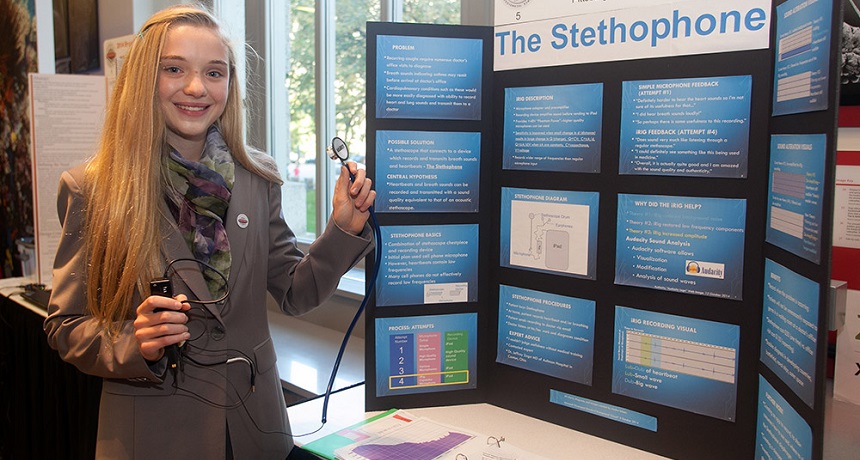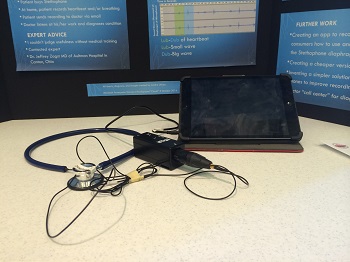A teen’s invention helps log asthma symptoms
The new stethophone can record heartbeats and breathing — then ship the data to your doctor

Annika Urban shows off her stethophone, an invention that records heartbeat and breathing sounds to send to the doctor.
L. Doane/SSP
Share this:
- Share via email (Opens in new window) Email
- Click to share on Facebook (Opens in new window) Facebook
- Click to share on X (Opens in new window) X
- Click to share on Pinterest (Opens in new window) Pinterest
- Click to share on Reddit (Opens in new window) Reddit
- Share to Google Classroom (Opens in new window) Google Classroom
- Click to print (Opens in new window) Print
Washington— An asthma attack can be a terrifying experience. One minute you’re fine, and the next you are fighting to breathe. Annika Urban, 13, found out firsthand that symptoms come and go very quickly. The teen decided to invent a device to record the sounds of asthma as they occur. She and other patients could then upload them to a computer and send them to their doctors.
The goal is to be able to alert doctors when a distant patient is having an attack. In some instances, this could decrease the time it takes to diagnose the disease and help patients get the proper medicine.
Annika showed off her invention at a competition in Washington, D.C., known as the Broadcom MASTERS (for Math, Applied Science, Technology and Engineering for Rising Stars). Society for Science & the Public runs the annual science competition, which is sponsored by Broadcom (a company that makes components to help you access the Internet wirelessly). The competition lets middle school students from around the United States share their science projects and inventions with each other and the public. (SSP also publishes Science News for Students and this blog).

Asthma is a disease that causes the lungs’ airways to become inflamed and swollen. Mucus can build up. Muscles around the airways tighten, limiting how much air can flow in and out of the lungs. During an asthma attack, people may cough, wheeze or feel that they can’t get air out of their lungs. In the United States alone, more than 25 million people suffer from asthma.
But its symptoms can emerge and disappear quickly. As a result, many patients will no longer be wheezing by the time they see a doctor. This can make it hard for doctors to diagnose the disease.
Annika’s new device might help speed those diagnoses. Her “stethophone” is a stethoscope — a device that detects heartbeats — paired with a microphone. Users can plug it into a smartphone or tablet computer. When someone has trouble breathing, the invention can store sounds of his or her breathing and heartbeat. Later, the patient can then send those recordings over the Internet to a doctor.
Designing the stethophone wasn’t easy. Annika found the microphone built into smartphones and iPads would not work for this application. “One of the first steps I went through was creating the device with a simple microphone and an iPad,” she says. “I was able to hear breath sounds but I was not able to hear a heartbeat.”
The teen realized she needed a more powerful microphone. She borrowed a very high quality one from her father, Nathan Urban. He’s a brain scientist at Carnegie Mellon University in Pittsburgh. His microphone easily picked up both the heartbeat and breathing sounds. But it was far too expensive for patients to buy for their personal use.
Annika knew she would need to boost the sound signal between the microphone and her iPad. The solution she came up with: a guitar amplifier. “I was able to hear heart and breath sounds extremely well and I sent these sounds to a doctor,” she says. “He was amazed at the sound quality and said it sounded like a regular stethoscope.”
The teen already has plans to improve her device. “I’d like to make an app to show the user how to record sounds, where to place the stethoscope and how to send it to the doctor,” she says. Annika hopes her device one day will find use all over the world. From battlefields to homes, it might quickly send symptoms for analysis by a doctor far away.
Follow Eureka! Lab on Twitter
Power Words
amplifier A device that boosts the power of a signal. For example, amplifiers are often attached to electric guitars to make them louder.
app Short for application, or a computer program designed for a specific task.
asthma A disease affecting the body’s airways,which are the tubes through which animals breathe. Asthma obstructs these airways through swelling, the production of too much mucus or a tightening of the tubes. As a result, the body can expand to breathe in air, but loses the ability to exhale appropriately. The most common cause of asthma is an allergy. It is a leading cause of hospitalization and the top chronic disease responsible for kids missing school.
inflammation The body’s response to cellular injury and obesity; it often involves swelling, redness, heat and pain. It is also an underlying feature responsible for the development and aggravation of many diseases, especially heart disease and diabetes.
smartphone A cell (or mobile) phone that can perform a host of functions, including search for information on the Internet.
tablets (in computing) A small, hand-held computer that can connect to the Internet and that users can control using a touch screen. An Apple iPad, Samsung Galaxy and Amazon Kindle Fire are all examples of tablets.